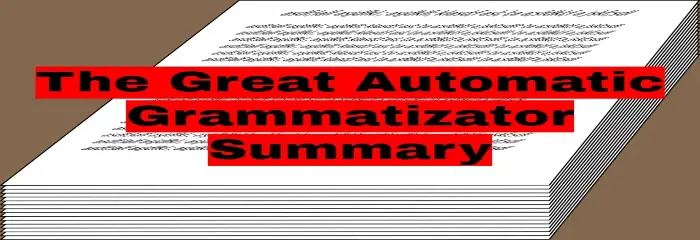
“The Great Automatic Grammatizator” is a short story by Roald Dahl, which first appeared in his 1953 collection Someone Like You. A lot of it can be read in the Amazon sample of The Umbrella Man and Other Stories. With the rise of increasingly sophisticated AI language models, it’s more interesting than ever. Here’s a full summary of the story, written by me, a person.
“The Great Automatic Grammatizator” Summary
Adolph Knipe is in the office of his boss, Mr. Bohlen, getting congratulated for his significant contribution to the great automatic computing machine they’ve built. The paper is reporting on its amazing capabilities—rapid electronic calculations, like providing an answer in five seconds to a problem that would take a mathematician a month. Mr. Bohlen is enthused but Knipe is indifferent. Bohlen insists Knipe take at least a week’s holiday to relax.
Knipe goes home to his apartment and has a drink. In his typewriter is a half-finished sheet of a piece of fiction. He’s tired of Mr. Bohlen and the computing machine.
Something dawns on him—a fascinating but probably impractical idea. Maybe a machine could be built to write stories. Like the computing machine, it could be fed all the data, words instead of numbers and all the grammatical rules. When given a plot, it would write the story.
Knipe works furiously for two weeks straight. He gathers all his papers and rushes to Mr. Bohlen’s office. He shows Bohlen the papers and talks for over an hour. Bohlen can see the genius behind the idea but doesn’t see any profit in it. He thinks Knipe is crazy.
Knipe explains his motivation. He’s not into his work at the firm. He has a creative urge and wants to be a writer. He’s written hundreds of short stories in the last ten years. None of them have been accepted for publication in a magazine.
Knipe explains the commercial possibilities of his proposed machine. He knows the type of stories the magazines pay for. The machine could be programmed to write exactly that sort of story. He estimates they could dominate a forty thousand dollar a week market. No human writers could produce stories as fast as the machine.
Mr. Bohlen is warming to the idea but still doubts it will work. Knipe expounds further on his plan. They’ll set up a literary agency and make up names for the writers. Mr. Bohlen himself could be credited on some of them. Advertisers will become interested in the writers as well.
“The Great Automatic Grammatizator” Summary, Cont’d
Knipe explains that plots are easy to come up with; he already has hundreds written down. The machine will also use the writer’s trick of using one big, obscure word per story to look clever.
Within a week, Mr. Bohlen endorses the project. They don’t tell anyone what it is. In six months, Knipe has completed the machine.
They’re both nervous as Knipe selects the type of story they want and starts it up. Almost immediately, sheets start coming out. They’re full of gibberish.
Four days later, Knipe has finished his adjustments and they’re ready to test it again. It produces a story but there are no spaces between the words.
A few days later they test it again. It’s perfect now. It produces a suitable story for a popular women’s magazine. Other stories, with one exception, are also good.
Knipe sets up the literary agency and starts sending out the stories. He has immediate success. In six months, they’re selling about fifteen stories a week. Knipe is developing an impressive reputation in the literary world. Mr. Bohlen is well-known too, but is not as respected as Knipe.
Mr. Bohlen wants the machine adapted for novels. He’s being urged to write one, and he wants it to be serious and intelligent. He suspects Knipe has been crediting him with some sillier work.
In a few months, Knipe has adapted the machine and added an impressive control system. Various aspects of the novel can be selected and combined. It’s designed so a person has to control the process while it’s happening, pushing and pulling on levers and pressing on pedals. Mr. Bohlen gets the hang of it after hours of practice and they’re ready to print.
Mr. Bohlen panics during the process and presses the pedals too hard, resulting in an offensive result. He tries again and gets a good novel. A publisher accepts it within a week. Knipe produces some novels as well. The agency develops a large list of promising young novelists.

Knipe wants to buy out the competition, by offering the most successful novelists money for the use of their names on the condition that they don’t write anymore. The creative urge is nonsense; writers only care about money. Reluctantly, Bohlen agrees they’ll try.
Knipe makes his visits. The first writer thinks he’s a lunatic and kicks him out. The second attacks him with a paperweight.
The third is intrigued and she agrees to go see the machine for herself. She produces a novel with it and signs the contract.
Knipe explains to Bohlen that she signed because the novel was better than her own. He decides to focus on mediocre writers only. After several months, he’s secured contracts with about seventy percent of his list.
The machine has been in operation for a full year. At least half of the published fiction in that time has been written by Adolph Knipe on the Great Automatic Grammatizator. More writers are signing up all the time.
It’s getting hard for those who still resist. As the narrator hears the howling of his nine starving children in the other room, he feels his hand moving closer to the contract on his desk. He prays for the strength to let the children starve.
I hope this summary of “The Great Automatic Grammatizator” by Roald Dahl was helpful.